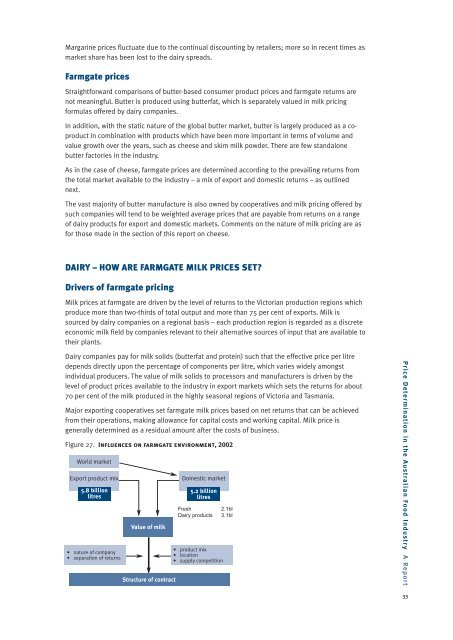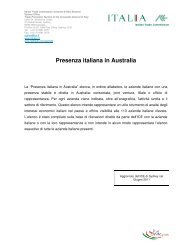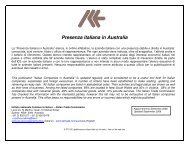Price Determination in the Australian Food Industry A Report
Price Determination in the Australian Food Industry A Report
Price Determination in the Australian Food Industry A Report
You also want an ePaper? Increase the reach of your titles
YUMPU automatically turns print PDFs into web optimized ePapers that Google loves.
Margar<strong>in</strong>e prices fluctuate due to <strong>the</strong> cont<strong>in</strong>ual discount<strong>in</strong>g by retailers; more so <strong>in</strong> recent times as<br />
market share has been lost to <strong>the</strong> dairy spreads.<br />
Farmgate prices<br />
Straightforward comparisons of butter-based consumer product prices and farmgate returns are<br />
not mean<strong>in</strong>gful. Butter is produced us<strong>in</strong>g butterfat, which is separately valued <strong>in</strong> milk pric<strong>in</strong>g<br />
formulas offered by dairy companies.<br />
In addition, with <strong>the</strong> static nature of <strong>the</strong> global butter market, butter is largely produced as a coproduct<br />
<strong>in</strong> comb<strong>in</strong>ation with products which have been more important <strong>in</strong> terms of volume and<br />
value growth over <strong>the</strong> years, such as cheese and skim milk powder. There are few standalone<br />
butter factories <strong>in</strong> <strong>the</strong> <strong>in</strong>dustry.<br />
As <strong>in</strong> <strong>the</strong> case of cheese, farmgate prices are determ<strong>in</strong>ed accord<strong>in</strong>g to <strong>the</strong> prevail<strong>in</strong>g returns from<br />
<strong>the</strong> total market available to <strong>the</strong> <strong>in</strong>dustry – a mix of export and domestic returns – as outl<strong>in</strong>ed<br />
next.<br />
The vast majority of butter manufacture is also owned by cooperatives and milk pric<strong>in</strong>g offered by<br />
such companies will tend to be weighted average prices that are payable from returns on a range<br />
of dairy products for export and domestic markets. Comments on <strong>the</strong> nature of milk pric<strong>in</strong>g are as<br />
for those made <strong>in</strong> <strong>the</strong> section of this report on cheese.<br />
DAIRY – HOW ARE FARMGATE MILK PRICES SET?<br />
Drivers of farmgate pric<strong>in</strong>g<br />
Milk prices at farmgate are driven by <strong>the</strong> level of returns to <strong>the</strong> Victorian production regions which<br />
produce more than two-thirds of total output and more than 75 per cent of exports. Milk is<br />
sourced by dairy companies on a regional basis – each production region is regarded as a discrete<br />
economic milk field by companies relevant to <strong>the</strong>ir alternative sources of <strong>in</strong>put that are available to<br />
<strong>the</strong>ir plants.<br />
Dairy companies pay for milk solids (butterfat and prote<strong>in</strong>) such that <strong>the</strong> effective price per litre<br />
depends directly upon <strong>the</strong> percentage of components per litre, which varies widely amongst<br />
<strong>in</strong>dividual producers. The value of milk solids to processors and manufacturers is driven by <strong>the</strong><br />
level of product prices available to <strong>the</strong> <strong>in</strong>dustry <strong>in</strong> export markets which sets <strong>the</strong> returns for about<br />
70 per cent of <strong>the</strong> milk produced <strong>in</strong> <strong>the</strong> highly seasonal regions of Victoria and Tasmania.<br />
Major export<strong>in</strong>g cooperatives set farmgate milk prices based on net returns that can be achieved<br />
from <strong>the</strong>ir operations, mak<strong>in</strong>g allowance for capital costs and work<strong>in</strong>g capital. Milk price is<br />
generally determ<strong>in</strong>ed as a residual amount after <strong>the</strong> costs of bus<strong>in</strong>ess.<br />
Figure 27. Influences on farmgate environment, 2002<br />
World market<br />
Export product mix<br />
5.8 billion<br />
litres<br />
• nature of company<br />
• separation of returns<br />
Value of milk<br />
Structure of contract<br />
Domestic market<br />
5.2 billion<br />
litres<br />
Fresh<br />
Dairy products<br />
• product mix<br />
• location<br />
• supply competition<br />
2.1bl<br />
3.1bl<br />
<strong>Price</strong> <strong>Determ<strong>in</strong>ation</strong> <strong>in</strong> <strong>the</strong> <strong>Australian</strong> <strong>Food</strong> <strong>Industry</strong> A <strong>Report</strong><br />
33







